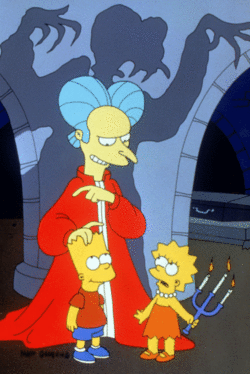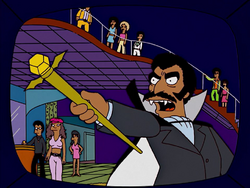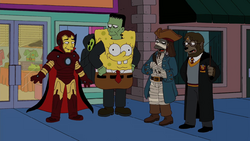| Picture
|
Season
|
Episode number
|
Episode name
|
Reference
|

|
5
|
86
|
"Treehouse of Horror IV"
|
The third segment, ‘Bart Simpson’s Dracula’, is largely a parody of the 1992 film “Bram Stoker’s Dracula”, with Mr. Burns appearing dressed up as Dracula in that movie. Waylon Smithers plays the part of Dracula’s servant Renfield. The scenes where Dracula’s shadow are cast against the wall is a reference to a famous scene from the Dracula movie ‘Nosferatu’ (1922), as well as scenes in ‘Bram Stoker’s Dracula’ where Dracula’s shadow is not in sync with his movements. Mr. Burns’ mansion is located in Pennsylvania, a pun on Dracula’s home province Transylvania in Romania.
|
|
|
6
|
108
|
"Sideshow Bob Roberts"
|
Dracula appears as a member of the Springfield Republican Party.
|
|
|
6
|
109
|
"Treehouse of Horror V"
|
In the segment “The Shinning” Dracula is one of the monsters who drags Homer away from the basement when he refuses to kill his family because he is too busy eating.
|
|
|
6
|
122
|
"Lisa's Wedding"
|
When Kent Brockman reads off a list of celebrities who’ve been arrested Dracula's wife is one of them.
|
|
|
13
|
276
|
"Brawl in the Family"
|
Dracula appears as a member of the Springfield Republican Party.
|
|
|
14
|
305
|
"Mr. Spritz Goes to Washington"
|
Dracula appears as a member of the Springfield Republican Party.
|

|
16
|
337
|
"All's Fair in Oven War"
|
A film named Blacula Meets Black Dracula is shown, which references the blaxploitation film “Blacula” (1972), a parody based on Dracula.
|
|
|
17
|
360
|
"Treehouse of Horror XVI"
|
Dr. Hibbert dresses up as Dracula, though Mayor Quimby assumes he is Blacula.
|
|
|
18
|
400
|
"You Kent Always Say What You Want"
|
Dracula appears as a member of the Springfield Republican Party and speaks with the accent used by actor Béla Lugosi in "Dracula" (1931).
|
|
|
19
|
410
|
"E. Pluribus Wiggum"
|
Dracula appears as a member of the Springfield Republican Party and speaks with the accent used by actor Béla Lugosi.
|

|
21
|
445
|
"Treehouse of Horror XX"
|
Dracula appears among various other classic monsters unable to scare off children anymore during Halloween. Once again he speaks in Lugosi’s accent. Later he dresses up as Iron Man.
|
|
|
22
|
468
|
"Treehouse of Horror XXI"
|
Dracula is portrayed as the father of Edmund, a vampire whom Lisa has a crush on. Later in the episode a vampire neighborhood is shown, also named after the novel: Dracula-la Land. One of the vampires seen there is Dracula as he is portrayed in the 1992 film “Bram Stoker’s Dracula", as well as Count Orlok from the Dracula movie "Nosferatu" (1921).
|
|
|
25
|
532
|
"Treehouse of Horror XXIV"
|
During the couch gag sequence Dracula can be seen among the monsters who chase after citizens, while in most horror movies it is the other way around. Among the characters in the field next to the Simpsons’ house we also spot Count Orlok from “Nosferatu”.
|
| 250px
|
25
|
536
|
"The Kid Is All Right"
|
Dracula appears as a member of the Springfield Republican Party.
|
|
|
27
|
579
|
"Treehouse of Horror XXVI"
|
Brian Kelley is credited as “Bram Shelley’s Dracustein”, in reference to Bram Stoker’s Dracula as well as Mary Shelley’s “Frankenstein”.
|




